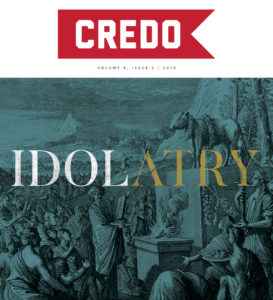In Identity and Idolatry: The Image of God and Its Inversion, Richard Lints examines imago Dei, a central biblical truth that we were created in the image of God. Cutting against the grain of culture’s prevailing thought, Lints acknowledges the difficulty of looking inwardly to discover one’s identity. Rather, he notes, it is when we look away from ourselves, to our Creator, that we will discover our true identity as image bearers. Only in Christ can we become reflectors of God’s eternal nature, something perfectly lost in the sin of Adam.
Identity and Idolatry is the thirty-sixth entry in the New Studies in Biblical Theology (NSBT) series, edited by D.A. Carson. Richard Lints is recognized as the Andrew Mutch Distinguished Professor of Theology at Gordon-Conwell Theological Seminary in South Hamilton, Massachusetts.
Chapter one introduces the problem of identity, referring to the film industry’s power to affect “reality” in the minds of viewers. While our culture projects a fluidity of identity, Lints argues for the “fixed points that tie us together and about which our classic religious convictions seek to make sense” (19). Marriage, though fractured by sin, is one over-arching biblical metaphor through which God chooses to reflect his character.
Chapter two examines the opening chapters of the Bible, establishing God’s perfect claim on his creation. As a result, Lints establishes “a strange bridge” between the images of God we were made to be, and the idols we choose to make. Genesis is not meant to answer every question of science, but to declare Israel as that community through which God would accomplish his purposes in the earth. Sadly, idols wreck this relationship, highlighting the promise of restoration through the coming savior. Identity and Idolatry reveals “the narrative arc of this story of image to idol and back again to image [through Jesus] that is told across the rest of this work” (42).
In chapters three and four Lints compares the two “tables” of creation found in Genesis 1:1-2:3 and 2:4-3:24. Moses prepares Israel for the idolatry of Canaan through the “hymnlike character of the first table” (49). However, after Genesis 11, Lints notes the phrase selem ‘elohim, the image of God, is absent from the rest of the canon. The reader is left to observe the ongoing power of idols and God’s resultant limited interaction with mankind, pointing to the coming of the Christ.
Chapter five examines Israel’s turning from YHWH, the “sworn protector Israel” (81). The golden calf becomes the “echo across the rest of the Old Testament …[serving] as a template for all of Israel’s unfaithfulness to YHWH” (89).
Chapter six marks the plot shift of the New Testament, “turning the story upside down” (103). In Jesus, mankind meets the “exact representation” of God, the true and perfect imago Dei (Col. 1:15). Says Lints, “human identity is most clearly seen in Christ, the one in whom, through whom and for whom humankind was made” (103).
Chapter seven interacts with nineteenth-century skeptics, from Kant to Nietzsche, showing how they effectively leveled their attacks on religion, “rail[ing] against the established church in much the same fashion that the Old Testament prophets railed against Israel’s idolatries in the seventh and eighth centuries BC” (129).
Finally, in chapter eight, Lints exposes the “plastic,” artificial nature, of our consumer-driven desire to create some “Disneyesque” sense of being. He outlines a roadmap for the recovery of our gospel-identity. Ultimately, the church will overcome idolatry when we find ourselves in Jesus.
At least four strengths make Identity and Idolatry a valuable read for the serious Bible student. First, the timing of the book is significant. As our culture continues to redefine human identity through an inner, subjective searching, the church must be able to counter with God’s original intent of identity. As our culture continues to redefine human identity through an inner, subjective searching, the church must be able to counter with God’s original intent of identity. As our culture continues to redefine human identity through an inner, subjective searching, the church must be able to counter with God’s original intent of identity. Click To Tweet We were meant to reflect his character.
Second, Lints is thoroughly biblical in dealing with human identity. He faithfully reminds the church that mankind’s true identity is still found in reflecting the character of God. The liturgy of the creation story helps the church to excel in the worship of God, who perfectly designed our complementary identities. The expositor trains his ear to listen for the echo of this imago Dei through the Old Testament, setting the stage for Christ Jesus’ perfect reflection of God.
Third, Lints’ summary of the Enlightenment-era skeptics’ effective use of the Old Testament prophets rebuke of idolatry is well done. In particular, the overview of Kant’s division “of intellectual inquiry into two separate domains, the sacred and the secular” (132), strengthens the expositor in the ongoing battle for truth.
Fourth, the final chapter of Identity and Idolatry helps the modern church in confronting our own idols while offering a way of escape: “Christians need to make the apologetic case that not all our desires are worth satisfying and many of them are conflicting ones. The greatest and deepest desires, for significance, for security, for eternity, can be satisfied only by being found in God’s redemptive grace in Christ” (171).
The weaknesses are few but consider at least three. First, Lints’ assertion that “believing something false about God is dangerous, but not nearly as dangerous as worshipping something other than him” (38) seems misplaced. Both ideas are dangerous. Who is to say one is more so than the other? Sound doctrine must be upheld at every turn, especially in our modern warfare for truth. Second, for those not schooled in philosophy, perhaps it would have been helpful to offer clear explanations of certain terms, e.g., “metaphysical”, the “noumenal world,” and “dialectical courage”, to name a few. Third, a more thorough dealing with the New Testament righting of the inversion of imago Dei would be helpful. Since the proclamation of the gospel allows for mankind to once again reflect God, how was that demonstrated through the ministry of the early church, particularly Paul’s missionary labors across the Roman Empire?
Lint’s placement of imago Dei as a main theme of biblical theology is appreciated. One cannot read the history of redemption without being moved at the inversion of mankind’s purpose. Created to reflect God’s glory, mankind now reflects his own humanity in dead idols. Thanks be to Christ Jesus who righted this inversion by his sinless life. Lints’ warning against the modern church’s own consumeristic idolatry is welcomed. May God rescue us from the unsatisfying, unfulfilling, “plastic narratives” of our times through the power of the gospel.


